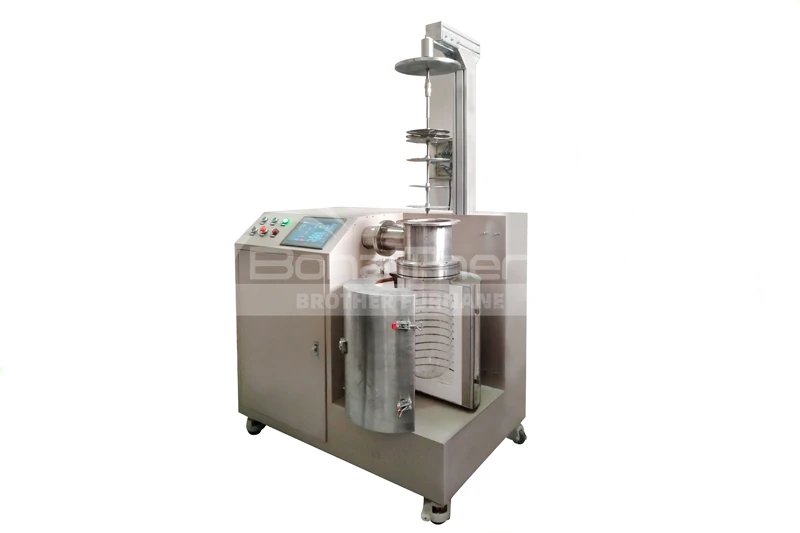Problems during the Use of Vacuum Furnace and the Corresponding Solutions
Some customers may encounter some problems in the process of using the vacuum furnace after purchasing the vacuum furnace from Brother Furnace. This article will provide you with a detailed introduction to some of the problems you may encounter in the process of using the vacuum furnace, and provide you with some solutions for reference.
What is a Vacuum Furnace?
Vacuum furnace is a device used to heat at high temperatures under low air pressure, and is widely used to treat materials such as metals, ceramics, and glass. Its main uses include heat treatment, annealing, sintering, and smelting, among other uses.
In a vacuum furnace, the air pressure inside the furnace chamber is reduced to a near-vacuum state to minimzse the effects of oxidation, contamination, or gases, resulting in higher material purity and better processing results.
The operating principle of the vacuum furnace is based on resistance or induction heating technology, whereby heat is transferred to the material inside the furnace using an electric current passing through a heating element or induction coil. In a vacuum environment, this type of heating allows for more efficient temperature and process control.
Common Problems and Solutions
1. Insufficient Vacuum
Problem:
Insufficient vacuum in the vacuum furnace leads to gas contamination and affects the quality of the material.
Solutions:
● Check the sealing condition: Regularly check the furnace door, gas inlet and outlet, and other sealing parts to make sure there is no gas leakage.
● Maintain the vacuum pump: Change the vacuum pump oil regularly, check the performance of the vacuum pump, and carry out the necessary maintenance.
● Replace the seals: It is recommended to replace the vacuum seals regularly, especially when the material is in a deteriorated condition.
2. Uneven Temperature
Problem:
Uneven temperature distribution in the furnace can lead to inconsistent material treatment results.
Solutions:
● Calibrate sensors: Calibrate temperature sensors and controllers regularly to ensure accurate temperature measurement.
● Optimize heating elements: Adjust the position and arrangement of the heating elements to ensure uniform heating.
● Test thermal field uniformity: Conduct regular thermal uniformity tests of the furnace to ensure that the temperature distribution is within the acceptable range.
3. Failure of Heating Elements
Problem:
The heating element may be damaged due to overheating or long-term use, affecting the heating effect.
Solutions:
● Regular Inspection: Regularly check the condition of the heating element of vacuum furnace, including the resistance wire, heating plate, or induction coil.
● Control the degree of load: Avoid overloading the heating element and make sure it works within the designed temperature range.
● Replacement and maintenance: Replace damaged heating elements in time and carry out necessary maintenance and adjustment.
4. Contamination of Materials
Problem:
Gas residues in the furnace chamber or volatilization of materials may contaminate the material being processed.
Solutions:
● Clean the furnace chamber: Thoroughly clean the furnace chamber before each use to remove possible contaminants.
● Use protective gases: Use appropriate protective gases, such as argon, during treatment to minimize material contamination.
● Selection of suitable materials: Use high-purity materials to avoid the introduction of impurities.
5. Control System Failure
Problem:
The control system may be operating inaccurately or out of control due to software or hardware problems.
Solutions:
● Maintain the on-board system: Regularly check and maintain the control system and update software and firmware to fix known problems.
● Backup and Test: Perform timely system tests and backups to ensure stability and reliability of operation.
Troubleshooting: Use troubleshooting tools to detect and fix problems in the system.
6. Gas Leakage
Problem:
Gas leaks can affect the efficiency and processing of the vacuum furnace and may lead to an unstable atmosphere in the furnace.
Solutions:
● Check gas pipework: Regularly check gas pipework and fittings to ensure they are well sealed.
● Detect leakage points: Use gas leakage detection instruments to monitor leakage points and deal with any problems found promptly.
● Repair and Replacement: Repair or replace faulty piping or joints to maintain the sealing of the system.
7. Deposits in Furnace Chamber
Problem:
Deposits in the furnace cavity may affect heating uniformity and material quality.
Solutions:
● Clean regularly: Clean deposits from the furnace chamber regularly, especially after high-temperature treatment.
● Use a protective cover: Use a protective cover or protective material during the treatment process to reduce the generation of deposits.
Optimize the treatment process: Adjust the process parameters to reduce deposits generated by material or gas reactions.
8. Insufficient Temperature Control Precision
Problem:
Insufficient temperature control accuracy may lead to errors in the material treatment process.
Solution:
● Calibrate the temperature: Regularly calibrate the temperature control system to ensure its accuracy.
● Improve the quality of the sensor: Use high-precision temperature sensors to improve the accuracy of temperature control.
● Control system optimization: Optimzse the algorithms and parameters of the control system to improve the stability and accuracy of temperature control.
Summary
With a detailed understanding of these potential problems and their solutions, you can effectively improve the operating efficiency of your vacuum furnace, thus ensuring the quality and stability of your material handling.
Brother Furnace not only provides you with answers to all your pre-purchase questions but also provides you with enthusiastic after-sales service. If you encounter any problems in the process of use, please feel free to contact us.











